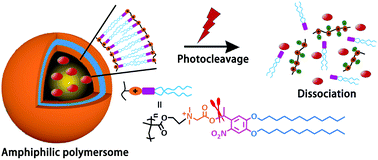Light-responsive polymersomes with a charge-switch for targeted drug delivery†
Abstract
Unlike the traditional block amphiphilic polymersomes, we herein report a lipid-like amphiphilic polymer that self-assembles into photo-responsive polymersomes for drug delivery. The introduction of a quaternary ammonium moiety not only provides a hydrophilic segment of the polymersomes, but also enables electrostatic adsorption with folic acid, thus achieving the targeting of cancer cells with overexpression of folate receptor. Upon light irradiation, the photocleavage reaction of the o-nitrobenzyl moiety disintegrates polymersomes by changing the polymer structure from cationic amphiphilic state to zwitterionic hydrophilic state, thus realizing photo-triggered drug release. The data showed that anticancer drugs (doxorubicin hydrochloride, DOX·HCl) can be loaded into the hydrophilic cavity of polymersomes and controllably released by photo-induced disintegration of polymersomes. Cellular assay showed that the active targeting of folic acid and photo-triggered release endowed the DOX-loaded polymersomes with a higher cytotoxicity to HeLa cells. Such cationic polymersomes provide a novel strategy for designing effective and intelligent drug carriers, and have potential application as a novel integrated platform for targeted drug delivery.



 Please wait while we load your content...
Please wait while we load your content...